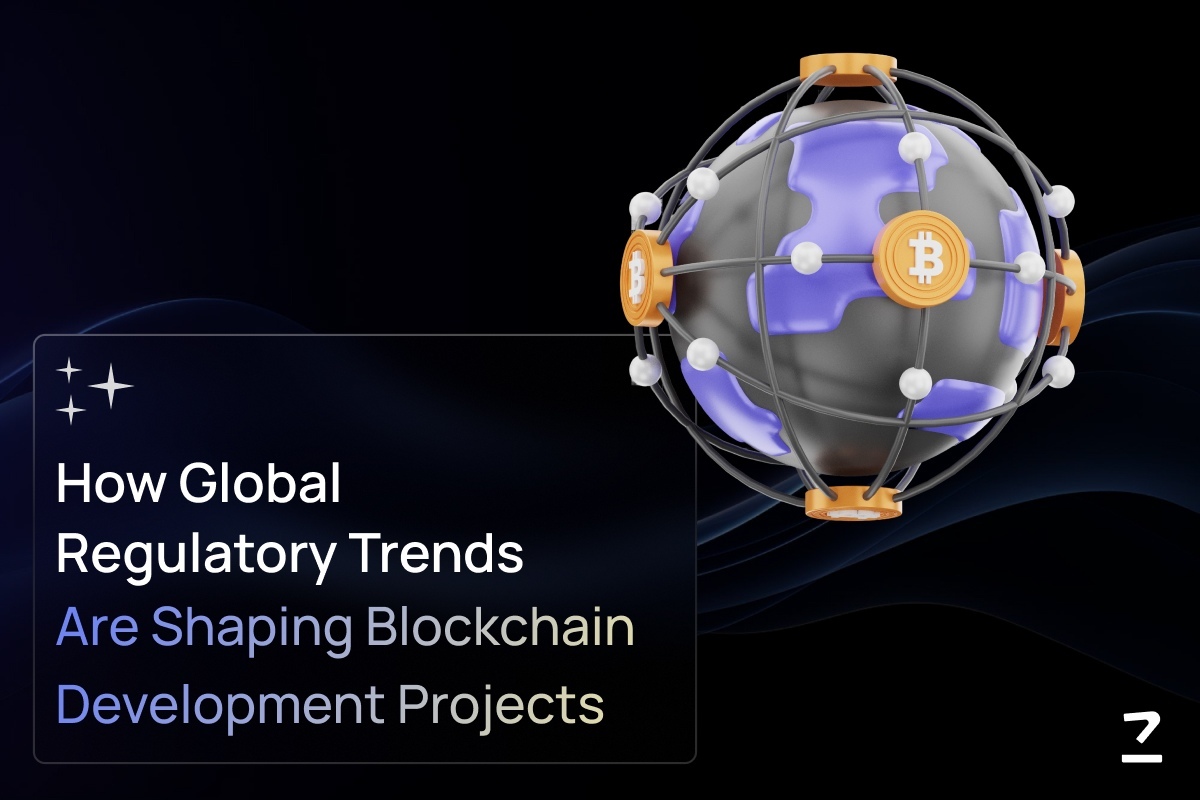SHARE THIS ARTICLE
Global Web3: A Race to the Top? How Different Countries Are Approaching Regulation
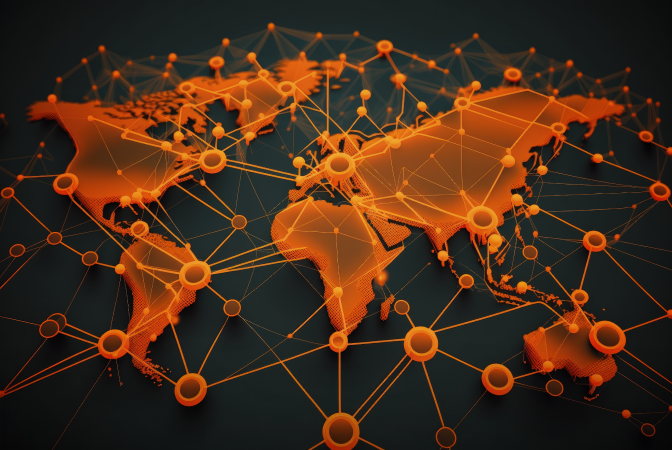
Web3 promises a fascinating future – one where you control your online data, interact with applications without relying on centralized platforms and own a piece of the digital infrastructure you use every day. Web3 is the next iteration of the internet and unlike the current Web 2.0 – dominated by centralized tech giants – it is built on the foundation of decentralization and user empowerment.
The growth of Web3 has been nothing short of phenomenal. In 2021 alone, venture capital investment in blockchain startups surged past a staggering $27 billion – a tenfold increase from the previous year. This explosive growth highlights the immense potential of Web3 but also underscores a critical challenge: regulation.
Web3 operates on the core principle of decentralization. Data and applications aren't controlled by a single entity but distributed across a network of computers. This shift puts the power into the hands of the users. They can own and manage their data, participate in governance decisions, and even earn rewards for contributing to the network. The promise is a more open, secure, and user-centric internet experience.
However, this decentralized nature also presents a conundrum for regulators. Traditional frameworks designed for centralized entities struggle to adapt to the borderless, permissionless world of Web3. Different countries have adopted vastly different approaches to regulation, creating a patchwork of rules that can be confusing for businesses and users alike. As a result, it becomes tricky for a Web3 development company to invest in a project when the regulatory framework is constantly shifting. Meanwhile, users face potential risks like scams, market manipulation, and security breaches without clear guidelines for consumer protection.
In this context, the question arises – will global Web3 regulation become a race to the top, promoting innovation and inclusivity, or descend into a chaotic landscape of conflicting rules? This blog dives deep into the current state of Web3 regulation across the globe, exploring the diverse approaches taken by different countries and the potential consequences for the future of the Internet.
The Balancing Act of Web3 Regulation
Web3, by its very nature, presents a unique challenge for regulators. Unlike traditional internet applications with centralized control points, Web3 operates on a decentralized structure powered by blockchain technology. This distributed ledger system allows for peer-to-peer transactions and eliminates the need for intermediaries like banks or tech companies. While decentralization offers numerous benefits, it also complicates the task of establishing clear rules and regulations.
Governments across the globe are grappling with a delicate balancing act: nurturing innovation in this burgeoning space while mitigating potential risks. On one hand, they want to create an environment that encourages the development of new technologies and applications within Web3. This could lead to a more open and competitive digital marketplace, with benefits for consumers and businesses alike.
On the other hand, governments have a responsibility to protect consumers from potential harm, such as fraud, scams, and market manipulation. Additionally, they need to ensure that Web3 doesn't destabilize financial systems or become a haven for illicit activities.
To address these challenges, countries are exploring various regulatory approaches. Some, like the European Union with its Markets in Crypto-Assets (MiCA) regulation, are opting for comprehensive frameworks that establish clear rules for the entire Web3 ecosystem. Others might choose a more sector-specific approach, focusing on regulating certain aspects of Web3 like cryptocurrency exchanges or decentralized finance (DeFi) platforms. Still, some might encourage a degree of self-regulation within the Web3 community, relying on industry standards and best practices to maintain order.
The specific approach each country takes will depend on its unique economic and technological ecosystem, as well as its risk tolerance. Regardless, it will significantly impact the future of Web3.
Different Regulatory Approaches (A Closer Look at Key Players)
With the stage set, let’s explore the specific approaches different countries are taking towards Web3 regulation. They are divided into four categories – the frontrunners, the cautious climbers, the emerging players, and the wait-and-see regions – each of them employing unique strategies.
The frontrunners – Europe (MiCA)
Europe has emerged as a leader in Web3 regulation with the introduction of the Markets in Crypto-Assets (MiCA) framework. This comprehensive legislation aims to establish clear rules for all aspects of crypto-assets, bringing much-needed clarity and stability to the European Web3 ecosystem.
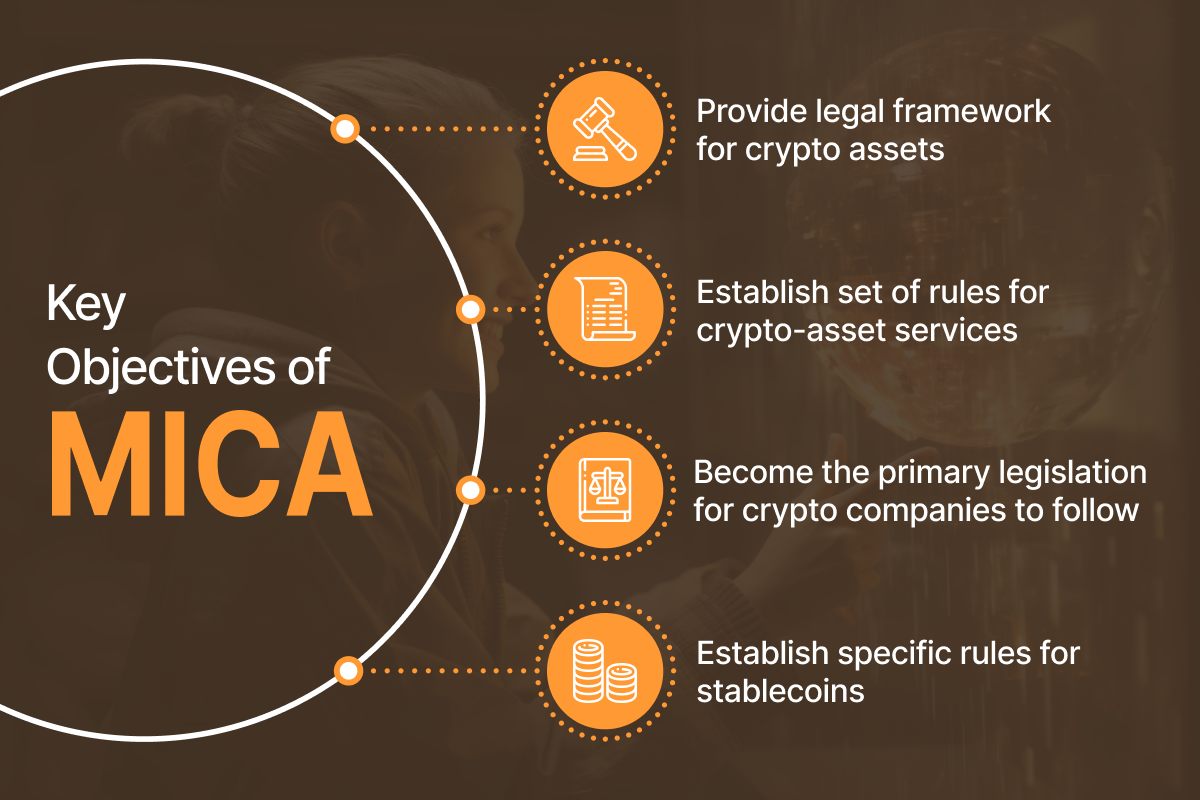 MiCA introduces several key aspects:
MiCA introduces several key aspects:
-
Licensing Requirements for Crypto-Asset Service Providers: Companies offering services related to crypto-assets, such as exchanges and custodians, will need to obtain a license from relevant authorities. This ensures a baseline level of competency and compliance within the industry.
-
Consumer Protection Measures: MiCA prioritizes user safety by mandating strong consumer protection measures. These include transparency requirements for crypto-asset offerings and provisions for handling customer complaints.
-
Anti-Money Laundering (AML) Regulations: To combat financial crime, MiCA incorporates robust AML regulations for crypto-asset service providers. These regulations will help prevent Web3 from becoming a haven for illicit activities.
The implementation of MiCA is expected to have a significant impact on Web3 development in Europe. By providing a clear regulatory framework, MiCA promotes innovation and attracts businesses to the region. However, some industry experts argue that MiCA's strict requirements might stifle innovation for smaller startups.
The Cautious Climbers – The United States
The United States currently lacks a unified approach to Web3 regulation. Different agencies oversee various aspects, leading to a fragmented landscape. The Securities and Exchange Commission (SEC) focuses on regulating cryptocurrencies as securities, while the Commodity Futures Trading Commission (CFTC) oversees derivatives markets involving crypto assets. Additionally, the Financial Crimes Enforcement Network (FinCEN) plays a role in implementing AML/KYC (Know Your Customer) regulations.
This fragmented approach creates uncertainty for businesses operating in the US Web3 space. However, recent developments indicate a shift towards a more comprehensive framework. In 2022, President Biden issued an Executive Order calling for a coordinated approach to digital assets across various government agencies. Additionally, ongoing debates in Congress suggest potential future legislation specifically targeting Web3 regulation.
The specific path the US takes will likely depend on the outcome of these ongoing discussions. Some experts advocate for a clear and consistent regulatory framework similar to MiCA in Europe. Others believe in a more flexible approach that allows for innovation while mitigating risks.
The Emerging Players – Asia (China, Singapore, and India)
Asia presents a fascinating contrast in approaches. On one hand, China has taken a strict stance, banning cryptocurrency transactions and exchanges within the country. This move reflects China's concern over financial stability and potential threats to its centralized control over the economy. The Chinese approach has undoubtedly dampened Web3 development within its borders.
On the other hand, Singapore has emerged as a regional leader in attracting blockchain businesses. The Monetary Authority of Singapore (MAS) has established a clear regulatory framework for digital asset issuance and trading, adopting a more relaxed approach and promoting innovation within the region. Singapore's openness has positioned it as a potential hub for Southeast Asian Web3 startups.
India, as of now, hasn't established a comprehensive framework for Web3. The Reserve Bank of India (RBI) has expressed concerns about cryptocurrencies but hasn't issued an outright ban. The government is currently evaluating the regulatory landscape and is expected to come out with a clear position soon.
These contrasting approaches within Asia highlight the complex interplay between boosting innovation and managing potential risks in the Web3 space.
The Rest of the World - A Wait-and-See Approach
Many regions in Africa and South America currently lack any formal Web3 regulations. This presents both risks and opportunities. On the one hand, the absence of clear rules creates uncertainty and hinders investment. On the other hand, it also offers a chance for these regions to leapfrog established players by developing innovative regulatory frameworks that attract businesses and talent.
The future of Web3 regulation in these regions will likely depend on their ability to learn from the experiences of others and adapt existing frameworks to their specific needs.
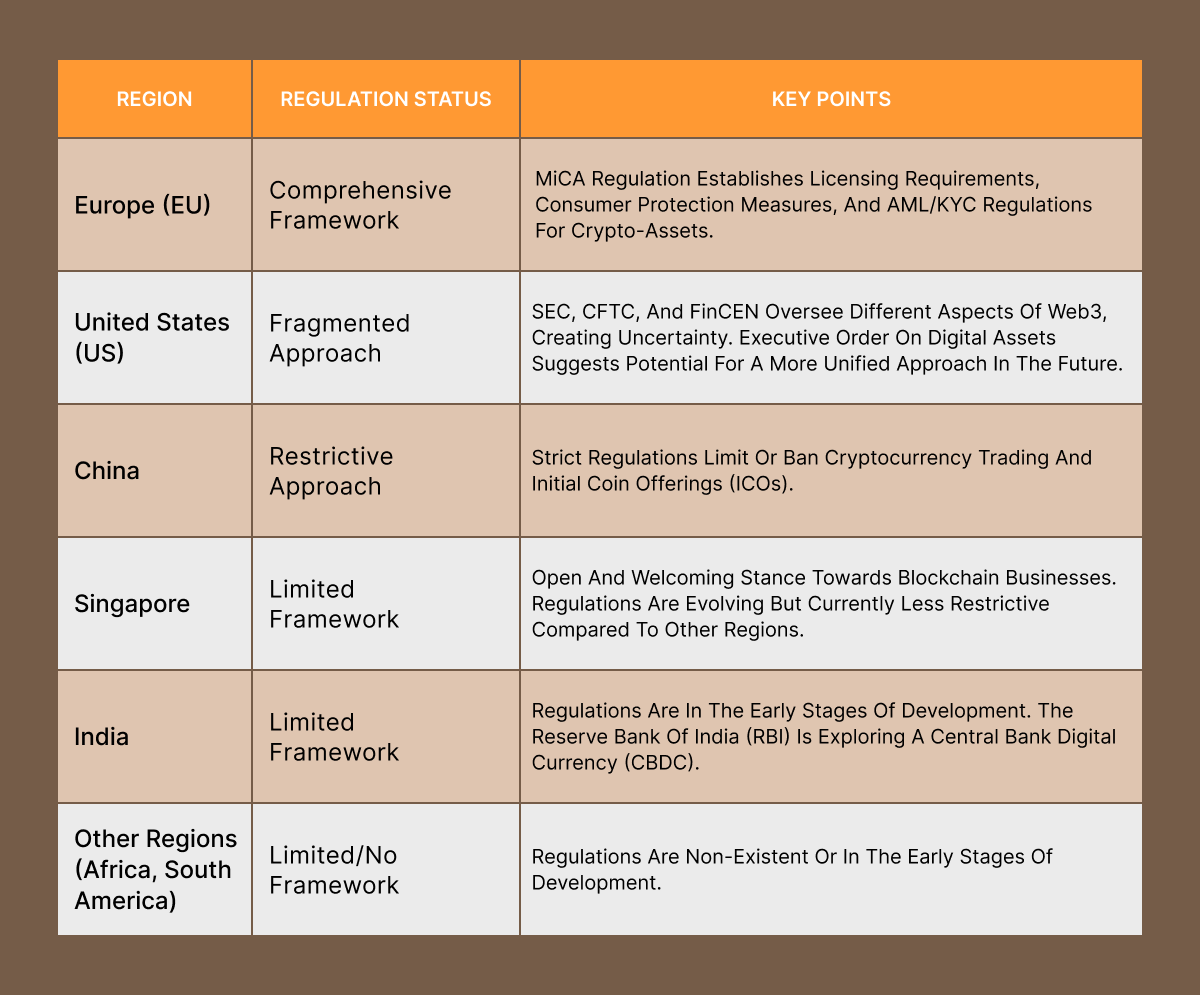 Balancing Innovation and Stability in a Fragmented Landscape
Balancing Innovation and Stability in a Fragmented Landscape
As we've seen, the current global state of Web3 regulation resembles a complex puzzle. Countries are taking vastly different approaches, creating a patchwork of rules that can be challenging to navigate. This lack of uniformity presents significant hurdles for both businesses and users.
Challenges of Inconsistent Regulations
Suppose a Web3 startup is aiming to offer its services globally. With varying regulations across different countries, this company would face a complex web of compliance requirements. Obtaining licenses in each jurisdiction could be costly and time-consuming, hindering their ability to scale effectively. Similarly, users exploring the Web3 space might encounter confusion. Regulations regarding token trading, dApp usage, and consumer protection can differ significantly depending on their location. This lack of clarity could discourage users from participating in the Web3 ecosystem altogether.
The Need for Collaboration
Clearly, the current situation calls for a concerted effort towards harmonization. International cooperation among regulatory bodies is crucial to establishing a cohesive framework for Web3. This collaboration could involve the following.
Creating Global Regulatory Standards
Establishing a set of baseline principles for Web3 regulation across different countries. These principles could focus on key areas like consumer protection, AML compliance, and market stability.
Establishing International Forums for Collaboration
Developing platforms for open dialogue and knowledge exchange between regulators from different regions. This could lead to a collaborative approach to tackling emerging challenges in the Web3 space.
By working together, regulatory bodies can create a more predictable and unified environment for businesses and users. This will not only promote responsible innovation but also address legitimate concerns about financial stability and consumer protection.
Potential Solutions
The path toward harmonization could involve several steps. One approach could be to develop international regulatory standards for Web3. These standards could provide a baseline level of regulation that individual countries can adapt to their specific contexts. Additionally, establishing international forums would facilitate collaboration and information exchange between regulatory bodies. Discussions in these forums could address emerging issues in the Web3 space and pave the way for coordinated responses.
Web3 Regulation - A Race to the Top or a Patchwork of Rules?
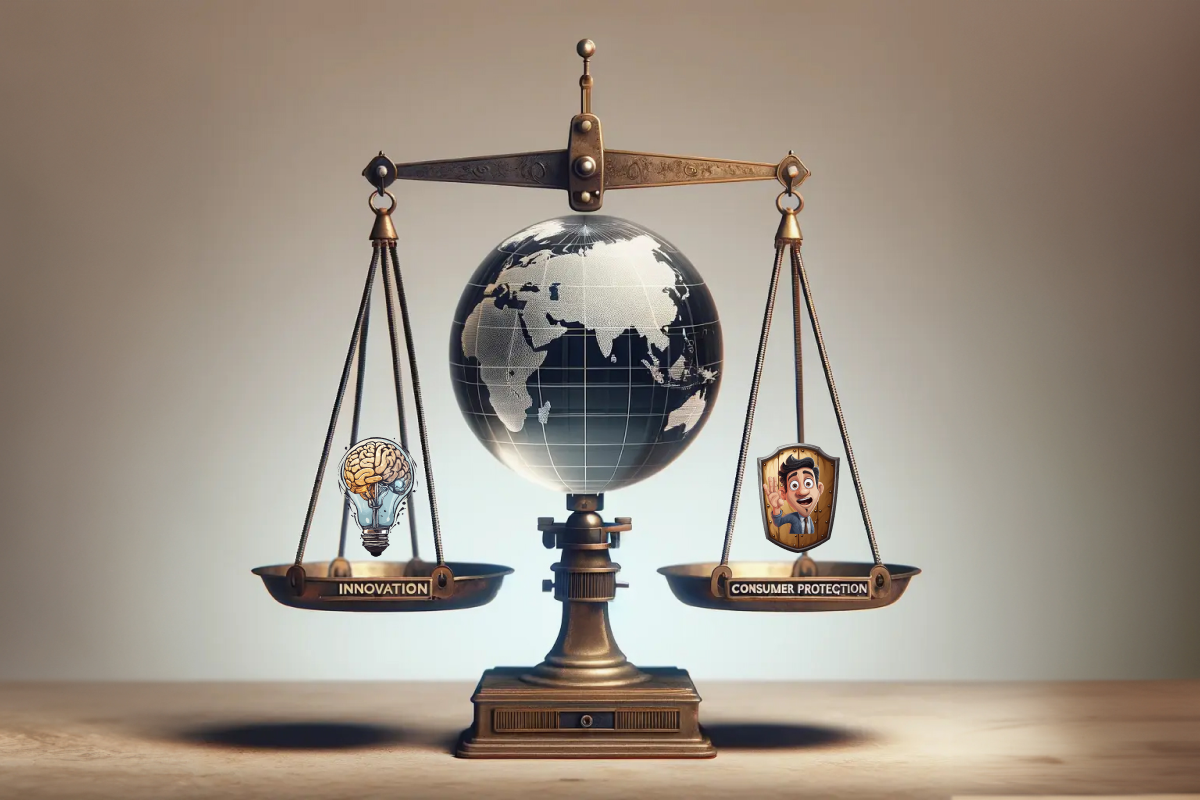
The current regulatory state raises an interesting question – are we witnessing a “race to the top” in Web3 regulations? Some countries might see the potential of Web3 to attract businesses and talent, leading them to adopt attractive and innovation-friendly regulations. This competition could ultimately benefit the global Web3 ecosystem by promoting innovation and growth.
However, there are also drawbacks to a fragmented approach. Businesses might be hesitant to enter markets and hire Web3 developers with unclear regulations, while users might face increased risks due to inconsistencies in consumer protection measures. Additionally, a patchwork of rules could make it easier for bad actors to exploit regulatory loopholes, potentially jeopardizing the overall stability of the Web3 ecosystem.
Finding the right balance is crucial. Ideally, we should strive for a global regulatory framework that promotes innovation while ensuring stability and consumer protection. As the discussions around Web3 regulation continue, it's important to consider the potential benefits of collaboration and harmonization. By working together, governments can create a more unified and future-proof regulatory environment for Web3, allowing this revolutionary technology to reach its full potential.
The Future of Web3 Regulation
Gazing into the crystal ball, what does the future hold for Web3 regulation? The global conversation around Web3 regulation is still in its early stages. However, there are positive signs that international collaboration could lead to a more unified approach. Organizations like the Financial Stability Board (FSB) are already facilitating discussions between regulatory bodies from different countries. These discussions can help establish common ground on key issues like AML/KYC regulations and consumer protection standards.
While international collaboration is crucial, industry self-regulation also has a role to play. Web3 is a rapidly evolving space, and traditional regulatory frameworks might struggle to keep pace. Industry players can work together to develop best practices and establish ethical codes of conduct. This self-regulation can complement government regulations and ensure responsible innovation within the Web3 ecosystem.
Looking ahead, the future of Web3 regulation is brimming with potential. By nurturing collaboration between governments and industry leaders, we can create a regulatory environment that allows Web3 to flourish. This environment should prioritize innovation while ensuring financial stability and protecting consumers. With a balanced approach, Web3 can revolutionize the internet, ushering in a new era of transparency, user ownership, and a more equitable digital space. The journey towards this future will be complex, but the potential rewards are incredible. As stakeholders continue to engage in constructive dialogue, we can be optimistic about the future of Web3, making way for a more decentralized and user-centric Internet.
Post Author

Explore Deep's insightful blog posts that help businesses stay ahead of the curve, explore new possibilities, and unlock the full potential of blockchain technology
Learn the ins and outs of the Web3 world for your upcoming project
With extensive experience in developing Web3 solutions of various scales, we at Codezeros can help you navigate the complicated Web3 space. Collaborate with us to ensure hassle-free development & deployment.

